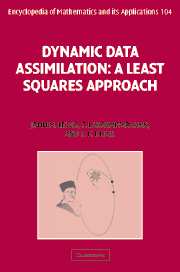Book contents
- Frontmatter
- Contents
- Preface
- Acknowledgements
- PART 1 GENESIS OF DATA ASSIMILATION
- 1 Synopsis
- 2 Pathways into data assimilation: illustrative examples
- 3 Applications
- 4 Brief history of data assimilation
- PART II DATA ASSIMILATION: DETERMINISTIC/STATIC MODELS
- PART III COMPUTATIONAL TECHNIQUES
- PART IV STATISTICAL ESTIMATION
- PART V DATA ASSIMILATION: STOCHASTIC/STATIC MODELS
- PART VI DATA ASSIMILATION: DETERMINISTIC/DYNAMIC MODELS
- PART VII DATA ASSIMILATION: STOCHASTIC/DYNAMIC MODELS
- PART VIII PREDICTABILITY
- Epilogue
- References
- Index
1 - Synopsis
from PART 1 - GENESIS OF DATA ASSIMILATION
Published online by Cambridge University Press: 18 December 2009
- Frontmatter
- Contents
- Preface
- Acknowledgements
- PART 1 GENESIS OF DATA ASSIMILATION
- 1 Synopsis
- 2 Pathways into data assimilation: illustrative examples
- 3 Applications
- 4 Brief history of data assimilation
- PART II DATA ASSIMILATION: DETERMINISTIC/STATIC MODELS
- PART III COMPUTATIONAL TECHNIQUES
- PART IV STATISTICAL ESTIMATION
- PART V DATA ASSIMILATION: STOCHASTIC/STATIC MODELS
- PART VI DATA ASSIMILATION: DETERMINISTIC/DYNAMIC MODELS
- PART VII DATA ASSIMILATION: STOCHASTIC/DYNAMIC MODELS
- PART VIII PREDICTABILITY
- Epilogue
- References
- Index
Summary
This opening chapter begins with a discussion of the role of dynamic data assimilation in applied sciences. After a brief review of the models and observations, we describe four basic forms – based on the model characteristics: static vs. dynamic and deterministic vs. stochastic. We then describe two related problems – analysis of sensitivity and predictability of the models. In the process, two basic goals are achieved: (a) we introduce the mathematical notation and concepts and (b) we provide a top-down view of data assimilation with pointers to various parts of the book where the basic forms and methodology for solving the problems are found.
Forecast: justification for data assimilation
It is the desire to forecast, to predict with accuracy, that demands a strategy to meld observations with model, a coupling that we call data assimilation. At the fountainhead of data assimilation is Carl Friedrich Gauss and his prediction of the reappearance of Ceres, a planetoid that disappeared behind the Sun in 1801, only to reappear a year later. And in a tour de force, the likes of which have rarely been seen in science, Gauss told astronomers where to point their telescopes to locate the wanderer. In the process, he introduced the method of least squares, the foundation of data assimilation. We briefly explore these historical aspects of data assimilation in Chapter 4.
Prediction came into prominence in the early seventeenth century with Johann Kepler's establishment of the three laws of planetary motion.
- Type
- Chapter
- Information
- Dynamic Data AssimilationA Least Squares Approach, pp. 3 - 26Publisher: Cambridge University PressPrint publication year: 2006



